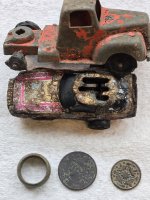Hi everybody,
I've recently purchased a home close to Dillwyn, Va and knew when I moved here that there were old mines and some still functioning. Behind my property there is a header creek to the larger watershed for the county and in every place I've dug a test there has been a blue/gray clay layer 8 inches down that is loaded with small and large Quartz of every color imaginable. I panned out a top layer of the clay and found a decent amount of black sand. I dug one spot out a little deeper and found degraded bedrock( maybe a layer of fragipan) almost a pasty dry shale/slate like rock substance about 2ft below the surface. It digs easily and gets rock hard at the bottom about 2 more feet down. I own about 600 ft of this creek and was wondering if I should start at the spring and work my way down or where I should dig? Also the strange degraded rock(fragipan), should I go down the bottom of it and try to find gold on top of the solid sheets at the bottom? There are also spots of a bright green substance around some of the Quartz (I assume is copper?) and just another piece of information, the bluish clay is almost like playdough. Does this sound like a place to search for gold/silver or am I only letting hopes get the best of me?
I've recently purchased a home close to Dillwyn, Va and knew when I moved here that there were old mines and some still functioning. Behind my property there is a header creek to the larger watershed for the county and in every place I've dug a test there has been a blue/gray clay layer 8 inches down that is loaded with small and large Quartz of every color imaginable. I panned out a top layer of the clay and found a decent amount of black sand. I dug one spot out a little deeper and found degraded bedrock( maybe a layer of fragipan) almost a pasty dry shale/slate like rock substance about 2ft below the surface. It digs easily and gets rock hard at the bottom about 2 more feet down. I own about 600 ft of this creek and was wondering if I should start at the spring and work my way down or where I should dig? Also the strange degraded rock(fragipan), should I go down the bottom of it and try to find gold on top of the solid sheets at the bottom? There are also spots of a bright green substance around some of the Quartz (I assume is copper?) and just another piece of information, the bluish clay is almost like playdough. Does this sound like a place to search for gold/silver or am I only letting hopes get the best of me?
Upvote
0








